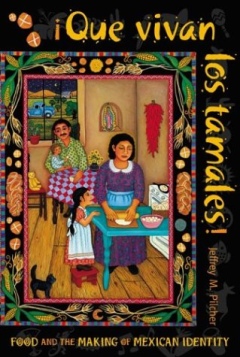Are you interested in the geography of Mexico’s regional cuisines or the historical relationships between food preparation methods and gender roles in Mexican society? If so, add ¡Que vivan los tamales! Food and the making of Mexican Identity by Jeffrey Pilcher to your “Books Wanted” list.
Pilcher’s lively and entertaining account analyzes how the history of food in Mexico has been intimately tied to the country’s evolving national identity. The connections have become widely recognized, so much so that UNESCO recently conferred Intangible Cultural Heritage status on traditional Mexican cuisine, especially that of the state of Michoacán.
 In every chapter, Pilcher delves into the details. He explains how Mexico’s elites strongly preferred dishes based on wheat (first introduced into Mexico by early colonists) to those based on corn, one of Mexico’s many contributions to world cuisine. Indeed, they went so far as to argue that, across the globe, societies based on corn or rice would never rise above those based on wheat.
In every chapter, Pilcher delves into the details. He explains how Mexico’s elites strongly preferred dishes based on wheat (first introduced into Mexico by early colonists) to those based on corn, one of Mexico’s many contributions to world cuisine. Indeed, they went so far as to argue that, across the globe, societies based on corn or rice would never rise above those based on wheat.
True appreciation of Mexico’s indigenous foods developed only slowly, mirroring the gradual development of nationalism, before coming to be considered a key component of the national identity. The advent of the railways in the 19th century allowed exotic foodstuffs to be marketed throughout the country for the first time. National cookbooks began to appear, highlighting the distinctive dishes of different regions, a trend continued to the present-day.
Technological developments have brought many changes. With industrialization, the time-consuming preparation of traditional corn tortillas was gradually superseded, especially in urban environments, by machine-made tortillas, whose taste is considered by connoisseurs to be greatly inferior to that of their hand-made equivalents, now increasingly restricted to relatively remote rural areas. Each step in the industrialization of tortillas brought massive social changes. Traditionally, the production of tortillas was the preserve of womenfolk, one of their numerous daily household chores. When mechanized tortilla presses were introduced, the making of tortillas quickly became an acceptable occupation for men. Freedom from the arduous work involved in making tortillas daily from scratch allowed women time to pursue other activities and to enter the formal workforce.
Gender, race, social class, dietary preferences, the fusion of indigenous cuisine and techniques with ingredients and methods imported from Europe and elsewhere… all are explored in this fascinating book.
Mexico’s cuisine is justly famous for its extraordinary regional variety; in just a few decades, the essential ingredients for Mexican food have become global commodities, appearing on supermarket shelves in dozens of countries around the world. Pilcher’s book puts this success in context, making it an essential read for anyone interested in the geography and history of Mexican cuisine.
Details (link is to amazon.com): ¡Que vivan los tamales! Food and the making of Mexican Identity by Jeffrey M. Pilcher (University of New Mexico Press, 1998).
Related posts:
- Mexico’s first cooks and the origins of Mexican cuisine
- Cuisine has changed as Mexico has experienced a nutrition transition
- The geography of Mexican cuisine
For more about Mexican cuisine, visit the amazing award-winning blog Mexico Cooks! and also browse the huge selection of recipes, articles and tips about all aspects of Mexcan food and cooking in the “Cuisine” section of MexConnect. ¡Buen provecho!
Sorry, the comment form is closed at this time.